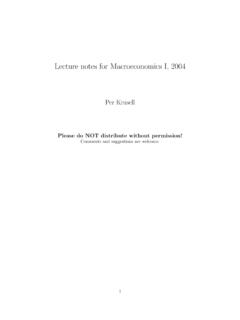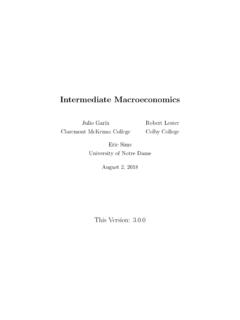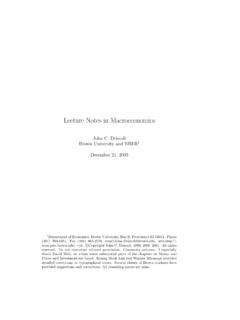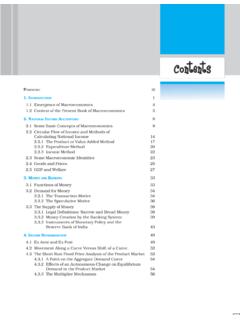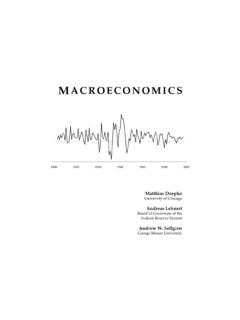Transcription of Economics AS Macroeconomics Notes - StudyWise
1 1 Created by Economics AS Macroeconomics Notes Aggregate Demand The total demand for a country s goods and services at a given price level and in a given time period. Aggregate Demand Formula: AD = Aggregate Demand C = Consumption / Consumer Expenditure I = Investment G = Government Expenditure X = Exports M = Imports Exports Imports Net Trade Net Exports Consumption / Consumer Expenditure Spending by households on consumer products Consumption is the largest component of AD Investment Spending on capital goods Investment is the most volatile component of AD Government Expenditure Spending by the central government and local government on goods and services This is education, health care and the police service NOT including transfer payments (housing benefit, job seeker s allowance and state pensions) / an increase in job seeker s allowance would be reflected in consumption as the increase in benefits will create an increase in disposable income that would then be spent on goods and services.
2 Transfer Payments Money transferred from one person or group to another not in return for any good or service Job seeker s allowance A benefit paid by the government to those unemployed and trying to find a job Exports Products sold abroad Imports Products bought from abroad Trade Surplus The value of exports exceeding the value of imports Trade Deficit - The value of imports exceeding the value of exports Real GDP - The country s output measured in constant prices and so adjusted for inflation Gross Domestic Product (GDP) The total output produced in a country AD = C + I + G + (X M) 2 Created by WII EU TIT (Consumption Determinants): W Wealth The more wealth people have (In the form of their home, savings account and shares), the more they are willing to spend Increased Consumption. Ex. Wealth can be spent or used to borrow against. It also results in greater consumer confidence I Income* Main determinant on consumption.
3 The larger the amount of income available the more disposable income available for use on spending. Increased Consumption | The distribution of income is also a factor as the poor spend a larger proportion of income so govt. measures that redistribute income from the rich to the poor are likely to increase Consumption. I Interest Rate If interest rates fall, people get less return on their savings and can borrow money for less Increased Consumption E Expectations If consumers are feeling optimistic about the future they are more likely to spend more Increased Consumption. This is why an increase in income can lead to a higher proportion of income being spent as well, as higher income can increase consumer expectation / confidence. U Unemployment A decrease in unemployment means more people have more disposable income Increased Consumption. T Taxes If taxes fall, disposable income rises Increased Consumption I Inflation If inflation is high and people expect price to rise then they may spend more now Increased Consumption | On the other hand if inflation is high people may instead increase their saving in order to maintain the real value of their saving.
4 T Technology Nowadays consumers have a tendency to throw away the old and buy the latest stuff Increased Consumption | New iPhone is released Wealth A stock of assets Property, shares and money held in a savings account Distribution of Income How income is shared out between households in a country Inflation A sustained rise in the general price level. Consumer Confidence How optimistic consumers are about future economic prospects Interest Rate The charge for borrowing money and the amount paid for lending money 3 Created by GAFIIES(Savings Determinants(NOT A COMPONENT OF AD!)): G Government Policy A policy to introduce tax-free saving schemes will encourage people to save more. A policy to raise state pension on the other hand would reduce the incentive for people to save for retirement. A Age Structure Of Population Young people tend to save very little. Middle- Aged people tend to increase their saving.
5 Elderly people tend to dissave in order to maintain living standards when they retire. On the other hand some pensioners continue to save in order to pay for care, medical treatment or just to leave inheritance money. I Real Disposable Income Whilst an increase in Real Disposable Income can increase spending it can also not only have the effect of households increasing saving but also saving a higher proportion of their income. I Interest Rate An increase in the Interest rate increases the reward on saving and so generally savings increases. On the other hand though some people are target savers aiming to achieve a particular sum in savings and so in their case higher interest rates reduce the amount they need to save and so in turn may increase spending. E Consumer Confidence and Expectations Households and firms tend to save more when they are uncertain or concerned about the future. S Saving Schemes Some saving is contractual. People agree to save a certain amount on a regular basis in insurance and pension schemes.
6 NOTE Increases in saving Decreased Consumption Fall in AD, ceteris paribus and vice versa Ceteris Paribus With other conditions remaining the same Saving Real disposable income minus Spending Target Savers People who save with a target figure in mind. Dissave Spending more than disposable income Savings Ratio Savings as a proportion of disposable income Net Savers People who save more than they borrow 4 Created by CuTE SPIRIT Pc (Investment Determinants): Cu Capacity Utilisation Firms are more likely to invest if they are operating at close to full capacity. On the other hand though if there is large spare capacity then it may be possible to increase output without investment. T Advances In Technology A firm may buy new capital equipment if it thinks that it will produce better quality products or produce products more cheaply. In either case the firm would expect to earn higher profit. In the first case it would be because the firm would anticipate higher demand, and in the second case the firm would anticipate that its unit cost would fall.
7 If other firms are investing in more new technology then a firm may be forced to do so as well in order to stay competitive and maintain profit levels. E Expectations About The Future Firms are more likely to invest if they feel optimistic about future economic prospects. The extent and speed of changes in expectations are the main reasons for the volatility of investment. S Subsidies An increase in subsidies effectively reduces the cost of production which in turn increases profits and so increases the amount of money available for Investment and so Investment may increase. P Profits High Profit Levels can encourage investment in two ways. They provide finance to invest but they also are likely to make firms more optimistic about the future. I Real Disposable Income If real disposable income is increasing , demand for consumer goods and services is also likely to be rising. This will mean it is likely the firm will need to expand their capacity.
8 In order for this to happen though the firm must be confident that the rise in demand will last and also that their existing capital is 100% insufficient to produce the required output. R Relative Factor Prices If the prices of other factors of production such as labour decrease then this will most likely decrease investment as firms may look to increase output via increasing labour rather than capital. I AM UNSURE ABOUT THIS ONE! I Interest Rates There are 4 reasons as to why an increase in IR would decrease investment: 1. It will increase the opportunity cost of investment: o A firm can use its profit for investment, placing it in financial institutions to earn interest or for distributing it to shareholders in the form of dividends. By choosing to use the profit on investment the firm sacrifices money that could have certainly been gained by placing it in a saving account in a bank. 2. Borrowing money for use on Investment would be more expensive: o Although most investment is from retained profit some is financed by borrowing.
9 Higher interest rates would make borrowing more expensive and so in turn make investment more expensive. 3. A higher interest rate will affect the expected return on investment: o Firms will anticipate consumer spending falling because borrowing is more expensive and saving would give a better return. 5 Created by 4. Higher interest rates reduce the demand for shares, which decreases the funds for available for investment: o This is because some people who may have bought shares may place their money in an interest-bearing account instead. The lower demand for shares will reduce the firm s price level and so decrease the funds that firms can raise for investment T Corporation Tax A decrease in corporation tax increases the amount of profit firms can keep and so in turn can increase investment. Pc Price of Capital Equipment A reduction in the price of capital equipment may increase investment. Such a fall may make it viable for more firms to use the equipment or firms already using the equipment to expand their capacity.
10 Capital Utilisation The extent to which firms are using their capital goods Corporation Tax A tax on firms profits Retained Profits Profit kept by firms to finance investment Unit Cost - Average cost per unit of output Accelerator Effect When an increase in national income / An increase in demand for consumer goods results in a proportionally larger rise in investment. Accelerator Effect / Theory: If demand is growing at a strong pace, firms will respond to growing demand by expanding production and making fuller use of their existing productive capacity. They may also choose to meet higher demand by running down their stocks of finished products. At some point, if they feel the higher level of demand will be sustained, they may choose to increase spending on capital goods in order to increase their spare capacity. If this investment goes beyond what is needed to simply replace worn out, fully depreciated machinery, then the capital stock of the firms will become larger.






